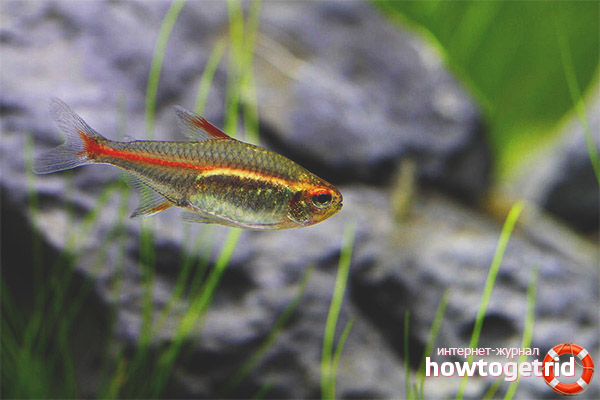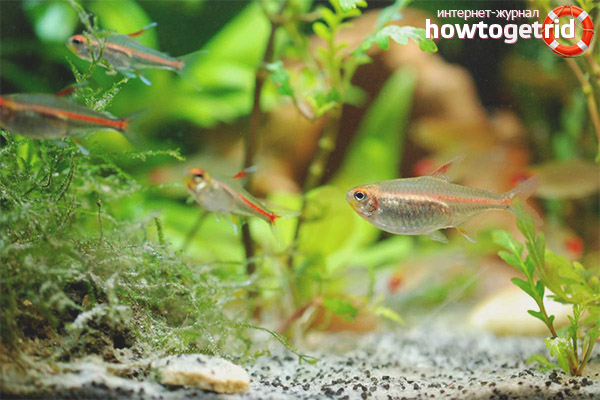The content of the article
Erythrosonus is a family of tetras, otherwise the aquatic inhabitant is called a floating firefly or a luminous tetra. A small aquarium fish has long been popular, because it is not whimsical in content, does not require special frills in the care. Suitable for beginners and professionals who are already accustomed to this field. A flock of erythrosonus will attract the attention of even the most avid aquarist, who has seen many varieties of fish. But let's not get ahead of ourselves, learn everything in turn.
Description
- For the first time this species of fish was described in 1909, since then a large-scale study and improvement of members of the family began. In the natural environment, fish can be found in South America, namely in the Essequibo River.
- Erythrosalonus settle in the tributaries of the channel, which are hidden from the eyes of dense forests. The water is brownish and dark from fallen leaves, increased or normal acidity, depending on the specific location.
- In their habitat, these representatives of the species prefer to stray in flocks, feeding on worms, vegetation and crustaceans. However, to date there are no fish caught from natural sources on sale. All of them are grown on farms and are supplied to aquarium shops.
- Erythrosonus is otherwise called Gracilis. Fine-bodied fish, the length does not grow more than 4 cm. In the aquarium, provided all the conditions for the content will live 3-5 years. According to its external features similar to black neonchikov. Due to the horizontal strip, the fish seem to glow.
- These fishes are transparent, on the body a horizontal stripe stretches along the sides. It goes from the head to the tail fin. The strip is red-orange, in young animals it is weakly expressed, but in mature specimens it is clearly visible. If you provide the correct lighting in the aquarium, the erythrosalonus will glow like neons.
- Erythrosonus is one of the most tranquil fish species. These inhabitants prefer to stray in flocks, so experts advise to keep them for 6-10 individuals or more. An aquarium with a volume of 60–70 l is suitable for this group.
- Fish of the represented family can easily exist in a peaceful aquarium. They get along well with danios, all other tetras, some types of gurus, rass collections. If erythrositis will have a peaceful temperament, then with proper provision of water volume, even corridors can be hooked to them.
- Summing up, we can say that erythrositis is quite peaceful and does not require frills in content. They are great for people who are just starting to master aquarism. It is also worth mentioning that the fish are active, like a muffled light.
- It is difficult to determine what gender an individual is in front of you. If it is a samochka, its abdominal region is more round, and the dimensions themselves are larger. The males are brighter and more refined.
Content
- The fish is hardy, quickly adapting to the environment. Suitable for inexperienced people who are going to breed aquatic inhabitants. At once we will say that for the full existence of their need to keep the packs. Buy 6-10 individuals minimum. Fish need soft water flowing through a peat filter.
- In order to repeat the natural biotope, it is necessary to put dried foliage or peat granules into the fish tank. As the first option is selected oak, alder foliage. Alder cones will do, but pre-sterilize and dry them.
- Since these fish will always give preference to living in a darkened space, send floating plants to the aquarium and install light-diffusing lamps if necessary. Remember that fish need space, so the middle part of the water is better not to plant with vegetation.
- As the soil is chosen river sand or other filler that you buy in the store. It is mandatory to install snags, roots, various decorations in the form of grottoes, stones, large pebbles, etc. It is good if the snags lightly tint and darken the water.
- Erythrozone requires cover, as well as vegetation, but not too thick. As for the parameters of the aquatic environment, fish are kept at a temperature of 23-28 degrees. Acidity should not go beyond the boundaries of 6-7.5 units, and the hardness - 2-15 units.
- The aquarium is inherently reminiscent of a closed space.For this reason, it is necessary to take care of him. Since fish leave behind a lot of waste, it is necessary to periodically replace a third of the water with new one. For this, 1 time in 15 days 30% of water is drained.
Feeding
- Erythrosalanus eat everything, so you can give preference to live or dried food, frozen food.
- In order not to disturb the balance of the aquatic environment, it is necessary to feed your pets daily with dry food in the form of flakes.
- Be sure to include in their diet small worm, artemia, pipemaker, etc. It is necessary to feed the fish with algae. Adhere to the proportions: dry feed is given 2 parts, frozen / live - 1 part.
Compatibility
- Erythrositis is excellent for keeping in common aquariums, where the same small fish live. To make them feel good, do not fall into stressful situations, it is necessary to keep tetra groups of 6 individuals.
- If you are going to arrange a common aquarium, then give preference to other tetras as neighbors. Well fit minor, neon blue, rodostomusy.
- It was already mentioned that erythrosonus can get along with gourami, corridors, rasborami, danios,viviparous aquatic pets.
Breeding characteristics
- Fish breed by laying eggs. When spawning begins, their fins shrink. Erythrositis markers spawn on vegetation. First, the female lays, then the male fertilizes.
- For a large number of fry, you must choose an aquarium with a volume of 35 liters. minimum. Plants such as Java moss or other floating species are placed in a reservoir designated for spawning.
- To protect the eggs, professionals advise to lay the bottom of the grid. For reproduction it is necessary to create favorable conditions. Thus, the temperature regime should not exceed the limits of 26-29 degrees. Fish love soft water with a pH balance of 5.5-6.7 units.
- Also, peat granules will not be superfluous, which are put to dye water in a dark color and for the purpose of filtration. Some install a regular filter, inside which there is a sponge.
- Representatives of the group spawn well in cases where about 10-14 individuals live in an aquarium. Half males, half females. Before you send fish to spawn, you need to feed them with live food.
As can be understood from all of the above, fish is not difficult to maintain in aquarium conditions. Everything that needs to be remembered is described in today's material. Do not forget that erythrositis will feel great if they contain flocks in dark water.













To send